After-Hours Tour of the Fraunces Tavern Museum: "Path to Liberty"
Explore a new exhibit inside the oldest building in Manhattan, a witness to history throughout the Revolutionary War Era!


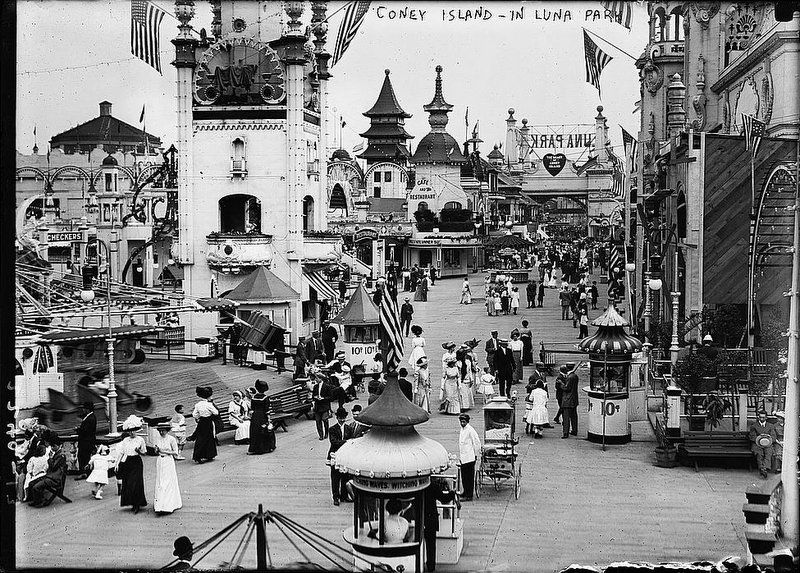
Many New Yorkers can remember amusement parks like Nunley’s in Nassau County and perhaps Palisades Amusement Park in New Jersey, yet there were at least 20 amusement parks in New York City’s history, many of which are obscure even to long-time city residents. Some may have even attended parks like Freedom Land in the Bronx and Rockaway’s Playland in Queens. Throughout New York’s history, amusement parks have had their fair share of economic distress. A majority have at some point suffered from disastrous fires, while others have suddenly closed due to construction projects. Here is our list of lost amusement parks, from the earliest to the most recent. Some closed as early as 1899 while others closed a decade ago.
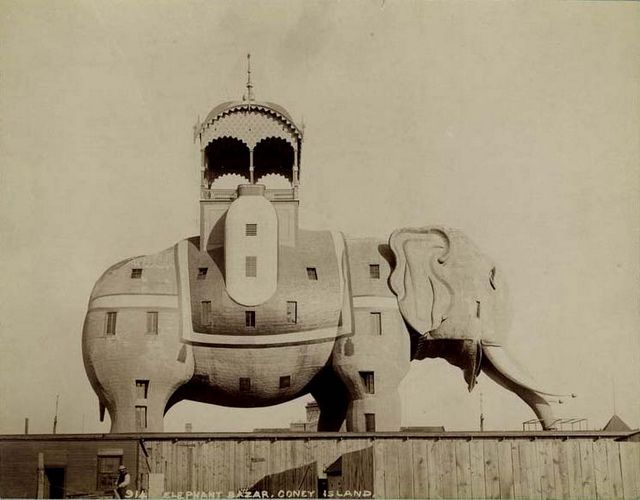
Between 1880 and World War II, Coney Island was perhaps the largest amusement area in the United States, attracting several million visitors a year. At its height, Coney Island housed three competing amusement parks: Dreamland, Luna Park, and Steeplechase Park. Coney Island also saw a number of more obscure amusement parks like the short-lived Sea Lion Park. The first roller coaster at Coney Island was LaMarcus Adna Thompson’s Switchback Railway, constructed in 1884 and cost five cents per ride. One year later, the Elephantine Colossus, a seven-story building in the shape of an elephant, opened to the public.

Coney Island’s first amusement park was Sea Lion Park, which operated from 1895 until 1902 before its replacement by Luna Park. Sea Lion Park was the first enclosed and permanent amusement park in North America. The park housed a ride called the Water Chute as well as the Flip Flip Railway. The amusement park was opened by Paul Boyton, known for purchasing Topsy the Elephant, yet he was forced to close the park as a result of loss of profit in 1902 due to poor weather.

The opening of Sea Lion Park quickly prompted entrepreneur George C. Tilyou to open Steeplechase Park in 1897, originally constructed as merely standalone attractions. The 15-acre park, with admission of 25 cents per person, featured dozens of attractions including a gondola ride called the Human Niagara, a Wild West sideshow, and an Aerial Racing Slide, as well as scale models of the Eiffel Tower and The Palace of Westminster’s Clock Tower. A 1907 fire started in the Cave of the Winds attraction, resulting in $1.5 million in damages, yet by 1909 Steeplechase Park was restored and reopened.
The park later saw the addition of the Parachute Jump following the 1939 World’s Fair, yet high crime and residential development led to the park’s closure in 1964. Fred Trump, the father of Donald Trump purchased Steeplechase Park in 1964 with grand hopes to build Trump Village, a waterfront housing complex on Coney Island.

Six years after Steeplechase Park opened, competitor Luna Park began operations in 1903 by Frederic Thompson and Elmer “Skip” Dundy. More than $700,000 was spent on constructing Luna Park following Sea Lion Park’s closure; some of the rides like Shoot the Chutes were left over from Sea Lion Park. The Oriental-themed park featured a 200-foot-tall Electric Tower in the center of a lake, buildings with domes lit up by electric lights, and The Dragon’s Gorge. A fire on August 13, 1944, destroyed much of Luna Park, and legal disputes over the park’s insurance money prevented it from ever reopening.
Dreamland was the last of the three original large amusement parks built on Coney Island, founded in 1904 by William H. Reynolds. The park was designed specifically to compete with Luna Park, known for its many rides and chaotic noise. In contrast, Dreamland featured refined architecture, a central tower with one million electric light bulbs, and (what was considered) high-class entertainment like Orient Theater’s “Feast of Belshazzar and the Destruction of Babylon.” Attractions included a “Lilliputian Village” with three hundred dwarf inhabitants, a Swiss alpine landscape, and even a display of baby incubators. Dreamland closed very shortly after its grand opening in 1911, due to a massive fire caused by an electrical malfunction.
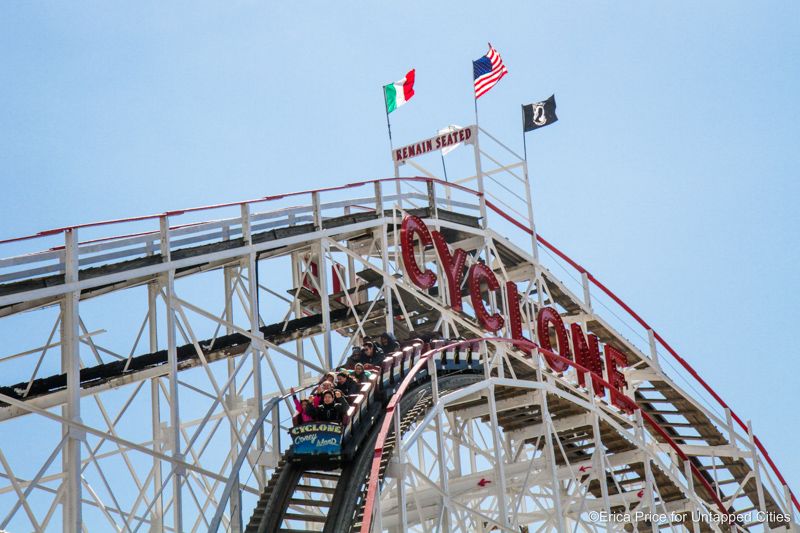
Much more recently was the closure of Astroland, open from 1962 to 2008, which was built as a “space-age” theme park. Rides included the Astrotower gyro tower, the Power Surge, and the Mercury Capsule Skyride. Astroland also operated The Cyclone beginning in 1975. The park continued the festive atmosphere of Coney Island for nearly five decades, yet the park closed in 2008 after it was purchased by the Albert family for $30 million, the land intended to be redeveloped into a year-round resort. A newly-built Luna Park opened in the spot of Astroland in 2010.

The prominent German-American Sulzer family opened one of New York City’s most popular beer gardens called Sulzer’s Harlem River Park and Casino. At the time, the Harlem River was the site of commercial shipping, leisure boating, and competitive rowing. Sulzer’s featured a carousel designed by Louis Bopp, a rifle range, dance halls, and ball courts, yet a 1907 fire destroyed much of the park’s property and cost an estimated $200,000 in repairs.
Although the park attracted immigrants from many different backgrounds, many activities took place over the now-forgotten Harlem African Burial Ground. Little is known about a nearby Harlem amusement park called Happyland Park, which opened in 1921 and was supposedly Blacks only.
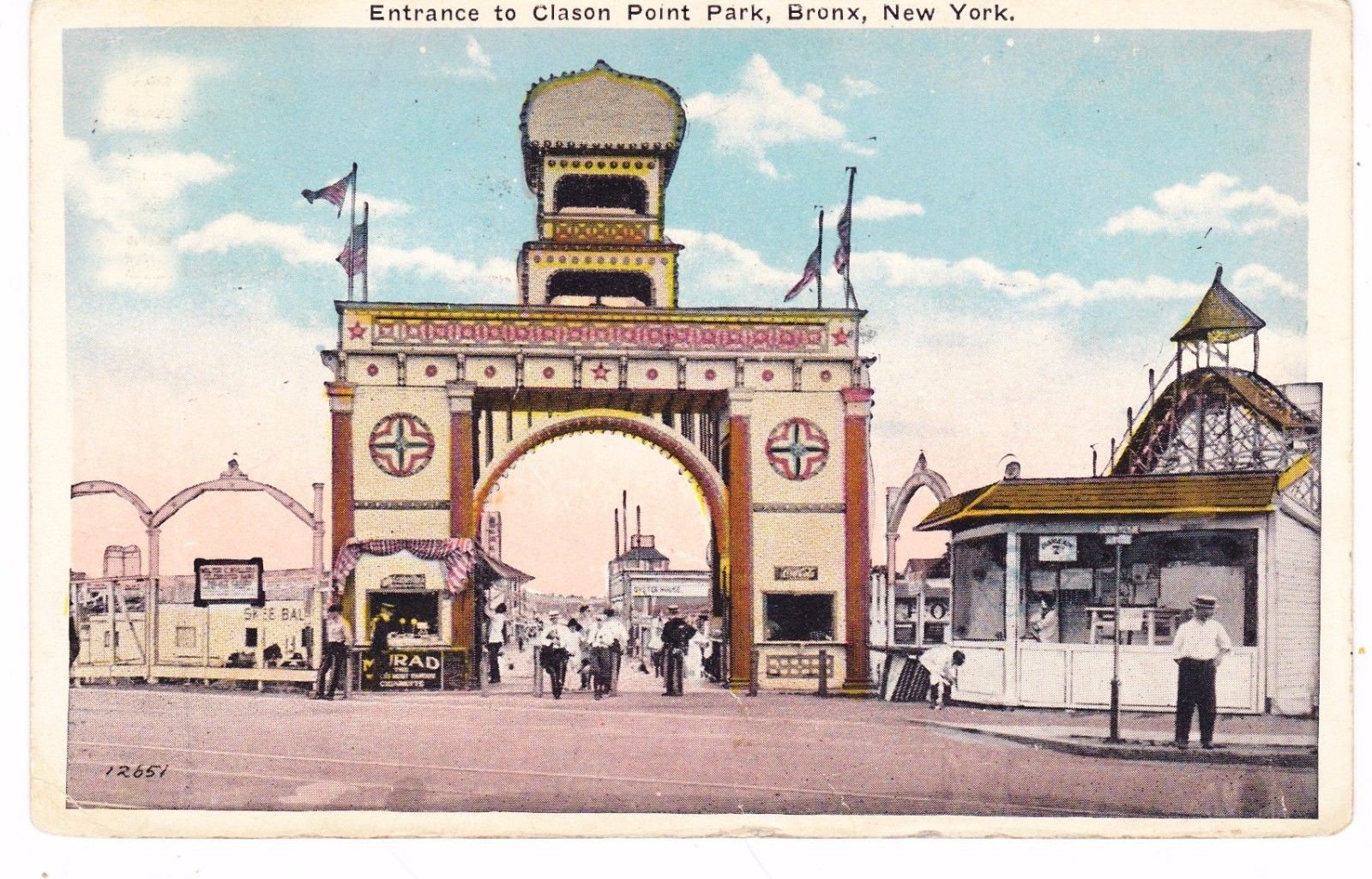
Nicknamed by some as the “Coney Island of the Bronx,” Clason Point Amusement Park operated from around the late 1880s to around 1935. As the area around Soundview Avenue in the Bronx became much more developed, with bungalows built around nearby Harding Park and the installation of a ferry system, the amusement park quickly became a tourist attraction. The park included a giant swimming pool that used water from the East River, yet it gained the nickname “the inkwell” for its dirtiness.
Unfortunately, the park is perhaps best known for a deadly accident in 1922, as a storm blew down an operating Ferris wheel killing six and injuring 22. Due to competition with two neighboring amusement parks and financial distress of the early 1930s, the park closed down, and in its place was a new private resort and pool called Shore Haven Beach Club opened in 1949.
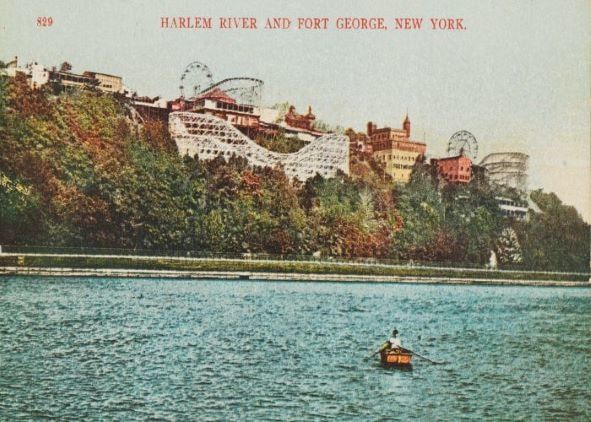
Fort George Amusement Park in Washington Heights, Manhattan, was a relatively short-lived amusement park open from 1895 to 1914. The park occupied an area between 190th and 192nd Streets and became known as “Harlem’s Coney Island.” The area initially consisted of a number of German-owned disjointed amusements, some of which operated at the wealthy site of Jones’s Wood. Many of those who came to the Fort George Amusement park were miners and foundry workers who helped construct the New York City subway uptown, operators of the trolley system, and the servants of the wealthy families who had moved uptown.
The park was known for its toboggan slide built by the Philadelphia Toboggan Company, a vaudeville stage built by Russian immigrants Joseph and Nicholas Schenck and theater operator Marcus Loew, and a 16-bucket Ferris wheel. The Schenck brothers built a new addition to the amusement park called Paradise Park, which had a 10-cent entry fee. There was a casino (in the old-fashioned sense of the word, “for socializing, not gambling”), according to the New York Transit Museum, a carousel, shooting galleries, a hotel, and more. The amusement park mostly burned down in a 1913 fire, and the park officially closed a year later, although a number of concessionaires continued to operate rides there for several more years.

Gala Amusement Park was located in East Elmhurst, Queens from around the late 1890s to the mid-1920s. The amusement park was part of North Beach, originally called Bowery Bay Beach, built by piano manufacturer William Steinway in partnership with George Ehret. At the time, North Beach was referred to as “The Coney Island of Queens” since it attracted more people than many of the parks in Brooklyn by the turn of the century.
Gala Amusement Park was known for its carousels, hot air balloons, and a Ferris wheel, supposedly the first on the East Coast. Visitors to the amusement park would often see theater acts, attend vaudeville shows, and witness boat races at North Beach, yet many of these festivities shut down as a result of Prohibition and pollution of the nearby Flushing and East Rivers. The site of the Gala Amusement Park later became the Glen H. Curtiss Airport, which then became North Beach Airport, and finally LaGuardia Airport.

Midland Beach, which neighbors South Beach on Staten Island, was home to a small amusement park from 1897 to the late 1920s. The small amusement park housed a roller coaster, a scenic railroad, and a number of smaller amusements. Like South Beach, Midland Beach experienced a rather disastrous beginning, facing major fires in 1916, 1924, and 1929. In 1917, a patron was left dangling from a roller coaster by his leg, and in 1918, a miniature train derailment injured 12 people. An extreme thunderstorm in 1923 led to a major fire, and trolley tracks were washed away by storm surges.
Many attractions at the amusement park were rebuilt throughout the park’s thirty-year existence, yet a 1929 fire destroyed more than one-fourth of the park, and Midland Beach became primarily used for swimming by 1930. Nearby, you will find what’s left of the abandoned Miller Airfield, which has been turned into a park by the National Park Service.

Ulmer Park in Bensonhurst is often ignored due to the success of nearby Coney Island, yet it was a prominent Brooklyn beer hall and amusement park from 1893 to around 1915, although some sources claim Ulmer Park closed as early as 1899. The park was opened by William Ulmer, one of Brooklyn’s most successful brewers of the time.
In addition to a beer garden, the park featured carousels and swings, rifle ranges, and a dancing pavilion. Supposedly 100,000 people gathered at the park at a “Saengerfest” festival. Yet, Ulmer Park shut just a few years after opening as Coney Island’s three competing amusement parks began to open.
Rockaway’s Playland in Queens was one of New York City’s longest-running amusement parks, open from 1902 to 1987. Rockaway’s Playland was created in 1902 by roller coaster designer LaMarcus Adna Thompson and reached its peak under A. Joseph Geist om 1928. At the time of the park’s opening, is was known simply as Thompson’s Amusement Park, operating as one of several amusement destinations along Rockaway Beach and Boardwalk. A nearby ferry dock allowed visitors from other boroughs to more easily access Thompson’s Amusement Park. The park was operated by Thompson’s family after his death for eight years, and it was then sold to Robert Katlin in 1927, who opened new facilities like a gymnasium and swimming pool.
The park gained the name “Playland” in 1928 after it was bought by A. Joseph Geist, a Queens lawyer who led the park’s expansion that added a dance hall, roller coaster, and menagerie. Robert Moses, as with many other amusement parks, shut down the amusement area in 1937 to build the Shore Front Parkway, and Geist lost half of his rides. Playland reopened in 1939 following a several million-dollar rebuilding program, yet the park struggled to gain revenue as World War II led to a wartime blackout in the area. 1949 saw the construction of Joytime, a kiddie park, and a modernization program that added new lighting systems. Playland’s popularity grew tremendously in the 1950s, as transportation to Rockaway Beach became significantly easier and as Playland began hosting contests like beauty pageants and children’s contests. Despite decreased attendance in 1964 due to the New York World’s Fair, the park quickly saw a rise in turnout for the next few years. Geist passed away in 1960, yet his son Richard took over control and kept the park alive for the next two-and-a-half decades. The park began to decline by the mid-1970s as many of the rides were dated, and the park closed after insurance premiums increased eightfold.
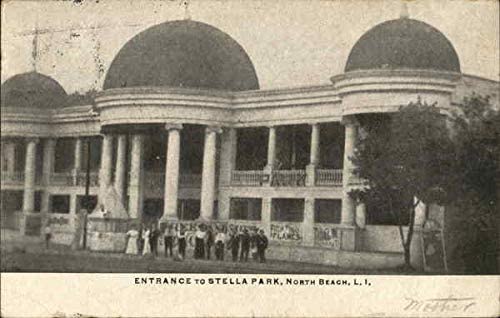
Stella Park was a relatively obscure amusement park around present-day Bowery Beach, then known as North Beach, near the Steinway area of Queens. Little is known about Stella Park, which opened in around 1906, although it was famous for its carousel which may have been operated by Frederick J. Droge. The carousel was mentioned in advertisements from 1907 to 1911.
A postcard from 1907 notes that Stella Park was “the only high class amusement park in greater New York with a picnic grove.” Attractions included a dog and monkey circus, a skating rink, a dancing pavilion, and a special attraction called “Man Against Bull,” in which a man named Shad Link would wrestle furious bulls.
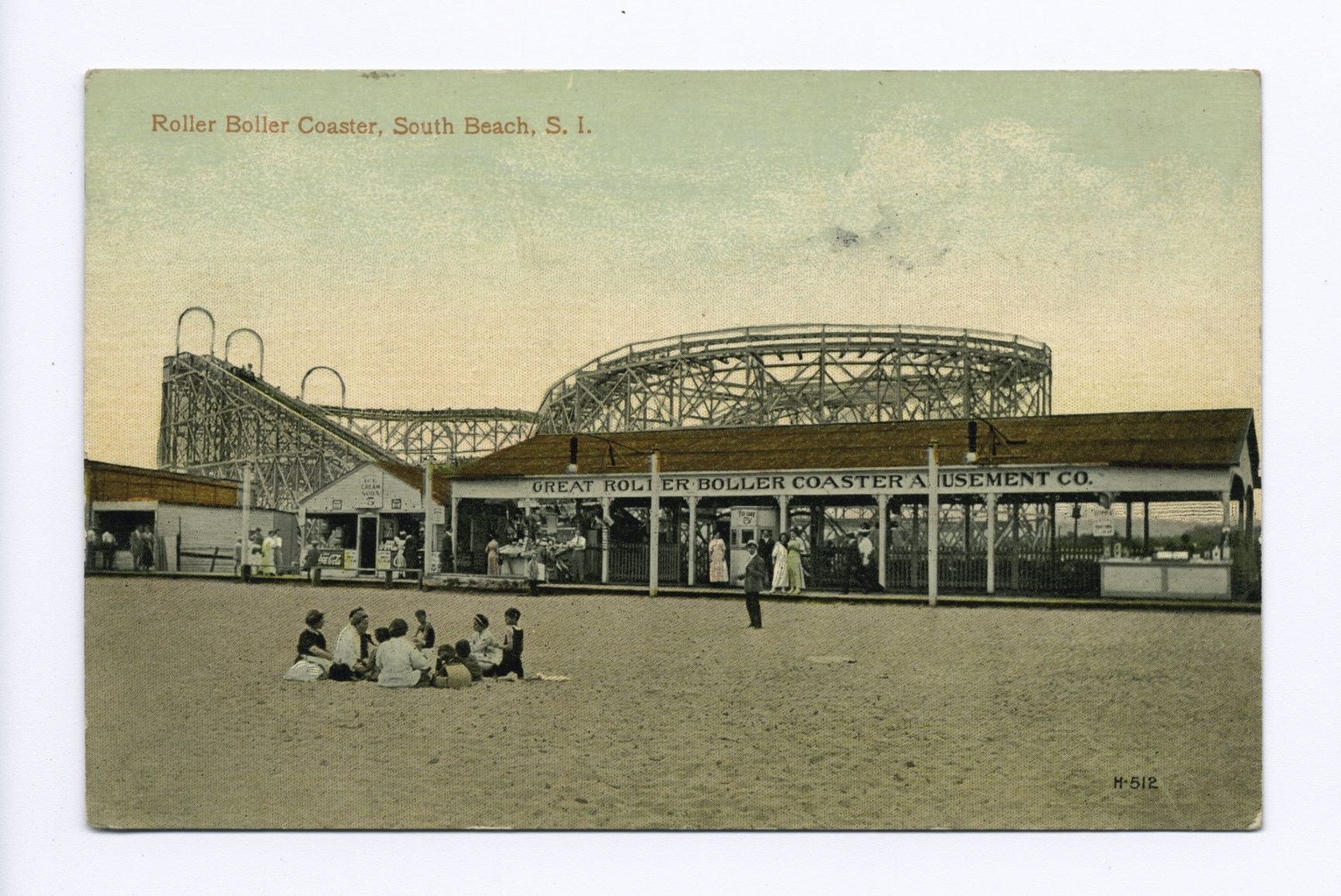
Happyland was an amusement park in South Beach, Staten Island, in operation from 1906 to 1935. South Beach is currently one of Staten Island’s most popular public beaches with a perfect view of the Verrazano-Narrows Bridge and the notable Franklin D. Roosevelt Boardwalk. The 15-acre amusement park opened at the South Beach boardwalk to excited families and theatergoers, as Happyland often staged productions and Vaudeville shows since many Broadway theaters shut for the summer.
The park was known for its Roller Boller Coaster, Japanese Tea Gardens, Canals of Venice, a shooting gallery, and a skating rink. Aviator Lincoln Beachey made two flights a day between Happyland and Manhattan for ten days in June 1907, surviving an incident in which his plane’s propeller got tangled with a balloon. Fortune tellers, card printers, and photography studios opened up right near Happyland in the 1910s, yet a 1919 fire destroyed 40 buildings. The park was rebuilt but never achieved its prestige of earlier years, and the park continued to decline after a series of five suspicious fires in 1929.
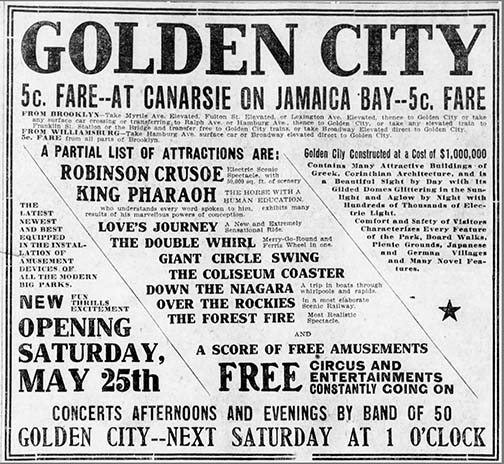
Golden City Park in Canarsie, Brooklyn, was a successful amusement park in operation from 1907 to 1939. William J. Warner, Jr. viewed the area of Canarsie as a profitable space that was closer to Manhattan and Queens than Coney Island and had accessible trolley routes and an elevated railroad system. Many buildings were constructed in the Grecian architectural style, illuminated by 145,000 lights at night. The park featured a sculpture of the Ben Hur chariot race, a theater with a capacity of 2500 people, and Over the Rockies, an elaborate 4,200-foot-long scenic railway. The park was still under construction at the time of its grand opening, yet most of the rides like the Coliseum Roller Coaster and Down the Niagara quickly became some of the park’s main attractions. Admission to the park was a mere 25 cents, and following a fire, the park quickly reopened with new attractions.
Parks Commissioner Robert Moses deemed the “nemesis of all New York’s amusement parks,” condemned Golden City in 1939 to build major roadways. The Belt Parkway later ran through the site, and although the New York City Board of Estimate noted that the park could be reopened further inland, Canarsie’s Civic Association resisted.
Starlight Park, now a public park along the Bronx River, was an amusement park open from 1918 to 1937. The park was built on the former site of the estate of William Waldorf Astor and was rebranded from the earlier Exhibition Park, built to commemorate the recent creation of Bronx County. Starlight Park featured shooting galleries, a dark ride, a baseball field, and rides like a roller coaster, Ferris wheel, and scenic railway. In 1922, additions like a sound system by the pool, electric riding cars, and performances were added to Starlight Park. The park’s reputation was negatively impacted after a rider was killed while standing up on a roller coaster, and a fire in 1922 destroyed Exposition Hall as well as the Ferris wheel. However, at its peak in 1926, the park had 26 rides and 150 concessions, with new features like the 15,000-seat Bronx Coliseum constructed at the park in 1929.
The park actually saw increased attendance in the early years of the Great Depression, installing several new rides and launching promotions like free-admission days and contests. Yet, like many amusement parks of the mid-20th century, a large fire destroyed a large section of the park; the Coliseum survived and was the park’s major source of income while redeveloping the park. The Coliseum actually hosted rallies of the USA Communist Party. By the mid-1930s, Starlight Park was seen less as an amusement park and more as a recreational park, with new sporting fields, a swimming pool, and picnic areas. Starlight Park was fully bankrupt by 1940, and a city park was later built in the 1950s.
South Beach Amusement Park, also known as Beechland Amusements, was the successor of Happyland in Staten Island’s South Beach, in operation from 1941 through 2006. The amusement park first opened up on the newly built Franklin D. Roosevelt Boardwalk, yet it soon after moved after the city banned commercial businesses from operating on the boardwalk. Supposedly, commercial establishments could not operate within 400 feet of the boardwalk, so South Beach Amusement Park’s owners relocated to Sand Lane approximately 401 feet inland.
The park included a Ferris wheel, a fun house, bumper cars, and an arcade. The park was the last amusement attraction on by the boardwalk, and now a series of houses occupy the land.
On Horace Harding Blvd in Elmhurst, Queens was Fairyland Park, which opened in 1949 as a restaurant and kiddie park. Just a year after opening, however, the park was relocated to Woodhaven Blvd and Queens Blvd to widen Horace Harding Blvd and turn it into the Long Island Expressway.
After relocating, Fairyland opened an indoor amusement spa, a steel roller coaster, and a number of other rides; five rides cost 25 cents. A favorite amusement spot among locals, the park suffered its second period of bad luck when the city forced Fairyland Park to close to give a property to a developer for the new Queens Center Mall.
Adventurer’s Inn was one of Queens’ most successful amusement parks, operating from the mid-1950s to the late-1970s off the Whitestone Expressway. By the 1970s, it was the only amusement park in Northern Queens, with notable rides like the Batman Slide, the Rotor, and the Toboggan. Originally called Adventure Park, the amusement park began rather sporadically with no standard schedule and just a handful of rides, yet under owner Harold Glantz and president Martin Garin, the amusement park expanded significantly.
However, this expansion would be rather short-lived, since by the early 1970s the city developed plans to convert the amusement park into a significantly less-fun industrial park. Many efforts were taken by the Public Development Corporation to close the park down, yet it appears that it remained open until 1978, surviving both a fire and a park shooting. The College Point Multiplex cinema now stands on the amusement park’s former grounds.
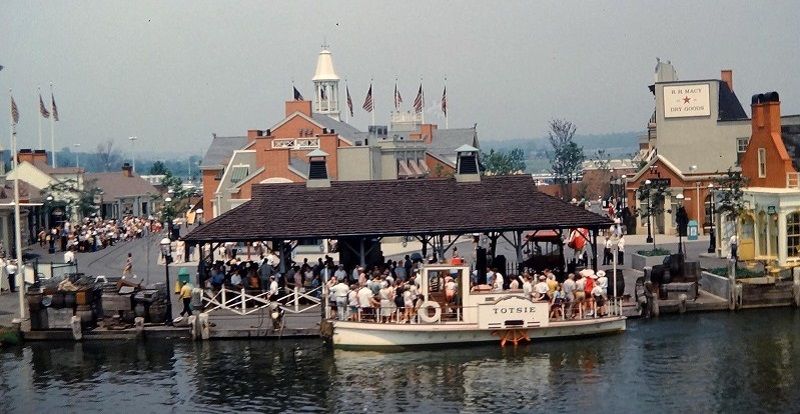
Freedomland U.S.A. was a short-lived yet very well-known theme park in the Baychester section of the Bronx. The park’s layout was designed by C.V. Wood and consisted of over 40 attractions in the shape of the contiguous United States. The park cost an astronomical $65 million to build, and one year after it opened in 1960, the park remained $8 million in debt. Freedomland was only 85% complete at the time of opening, yet despite this admission was $1.50 for adults, with an additional surcharge of up to 50 cents for some rides.
The park featured a number of sections inspired by different geographic regions of the United States, with corresponding rides, restaurants, and interactive activities. Little Old New York, inspired by life in the late 19th century, featured a Horseless Carriage, Shuntz’s Delicatessen, and New York Harbor tug boats. Old Chicago featured elements like an Indian Village and a building that would “burn” with flames extinguished by character actors, while The Great Plains included a version of the Pony Express, a working farm, and a shooting gallery. Other regions included San Francisco, The Old Southwest, Mardi Gras-themed New Orleans, and Satellite City.

Photo courtesy of Thomas X. Casey
Despite the park’s appeal, Freedomland faced further financial strain by 1963, and a portion of the park was sold to a pension fund of the Teamsters Union. The park filed for bankruptcy on September 14, 1964, and today the site was redeveloped as Co-op City, the largest housing cooperative in the world.
Next, check out 12 Buildings That Should Be Brought Back in NYC!
Subscribe to our newsletter